2020 Corvette C8 Stingray Z51: First Drive
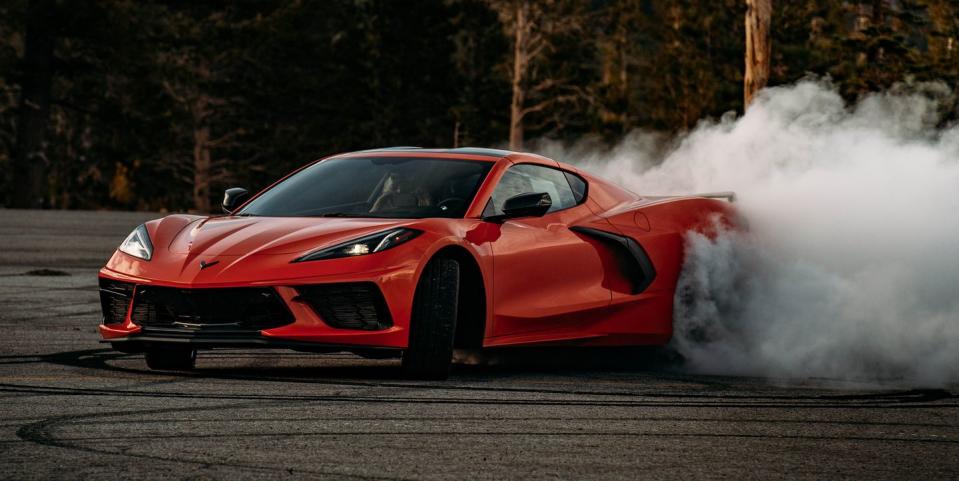
Let’s get one thing out of the way: the 2020 Chevrolet Corvette is good. It’s not, however, great.
The C8 Corvette is, without question, the most significant car of the year. It retains the previous Corvette’s main characteristics: big performance from a burly V-8, a bargain price, SMC (composite) body panels, and an aluminum frame. But, for the first time ever, the engine moves to the middle and ditches the manual transmission to close the gap between it and those pesky European supercars. It’s a huge moment for Chevrolet.
It’d be very easy to confuse the importance of this new Corvette with its greatness. But we’re leaning the other direction. If anything, it’s a potentially great car that's not quite there yet.
This harsh judgment comes not from a cynical reaction to the buzz surrounding the Corvette, but instead as a function of GM’s past performance. Like that unfair high-school teacher who rounds down your grade because he thinks you can do better, we’re reducing the C8’s verdict from “great” to merely “good.”
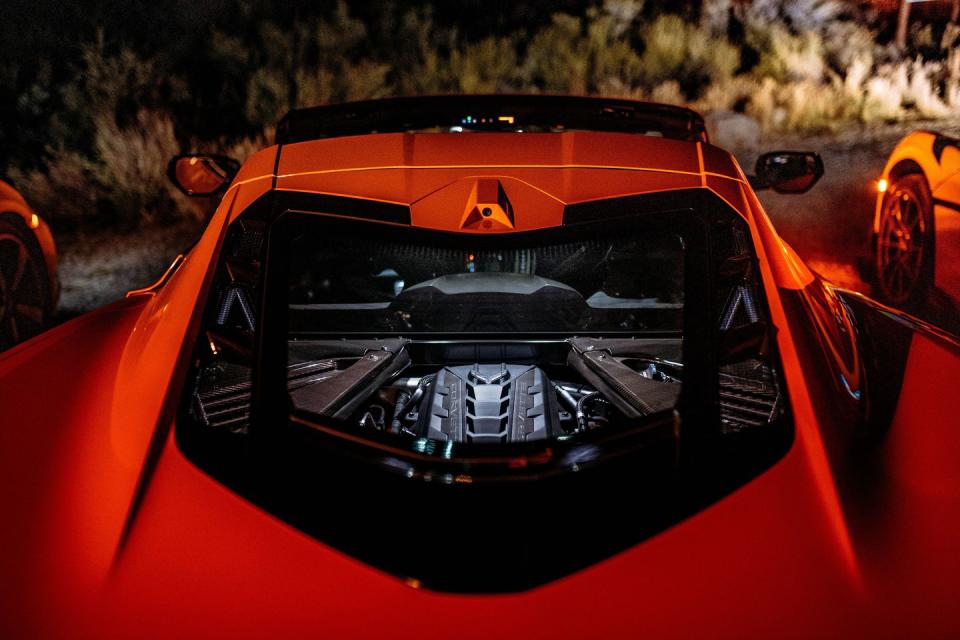
But we don’t just think Chevrolet can do better, we know it can. GM’s chassis tuning is, typically, among the best in the business. It’s sometimes even the best, showing companies like Porsche and Ferrari how a car should feel and how it should respond. The last-generation, C7 Corvette Stingray was nothing short of magnificent.
The C8 isn’t quite there. It has neither the limit-handling grace of a 718 Cayman or the ESP-assisted Stealth-Fighter moves of a Ferrari 488 Pista.
What it does have is the ability to show Rolls-Royce how to tune a chassis: the new Vette genuinely rides like full-size luxury car. No car with sporting intention this side of McLaren’s Super Series of cars with trick hydraulic suspension even comes close to the suppleness of the Corvette.
Astonishing magnetorheological-damper ride quality aside, the C8’s driving experience is a radical departure from previous Vettes because its controls are delicate. The electrically assisted steering is light, the shift paddles don’t require much effort from your fingers, and the (brake-by-wire) left pedal won’t stress your thigh muscles. The experience is more Ferrari than C7, which was a big brute of a thing that had a heavy clutch, a shifter that could sprain a limp wrist, and enough driveline lash to remind you what the gritty side of Detroit still looks like.
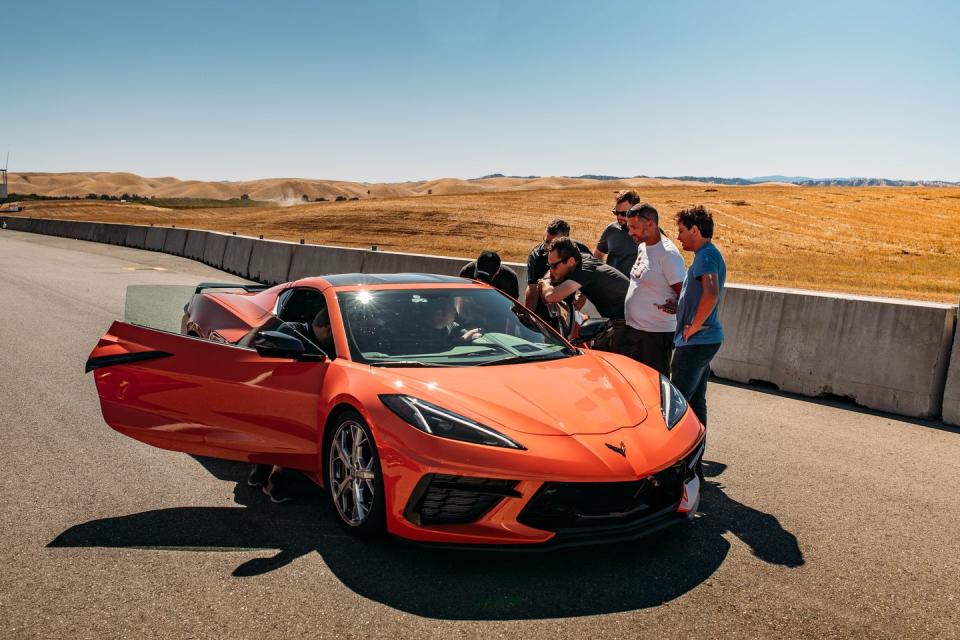
Speaking of grit, there were a few bugs with this C8. We’re incredibly thankful that GM took the risk in allowing us to drive an early, pre-production car rather than making us wait months until everything was finalized. The bugs we saw were typical of prototypes, so we won’t mention them.
That said, we’re left with a few impressions about the transmission that we think will endure even once it receives final production software. The good news is that the Corvette’s first-ever 8-speed dual-clutch automatic moves the car off the line smoothly, and shifts are executed with less of a delay than with the old 8-speed automatic. And then there’s the less-than-good news: we doubt, even once it’s in production tune, that the Tremec dual-clutch will respond to shift commands as quickly as the DCTs from Porsche, McLaren, or Lamborghini. Ditto with actual shift times. This transmission, at least in preproduction trim, seems a good ways off the best.
The updated 6.2-liter LT2 V-8 now makes 495 hp and 470 lb-ft of torque, gains of 35 and 10, respectively. Those are relatively modest increases in a turbocharged world where a few lines of computer code can add multiples of that—but the Small Block remains an elegantly engineered throwback to a time where engines made great noises and responded instantly.
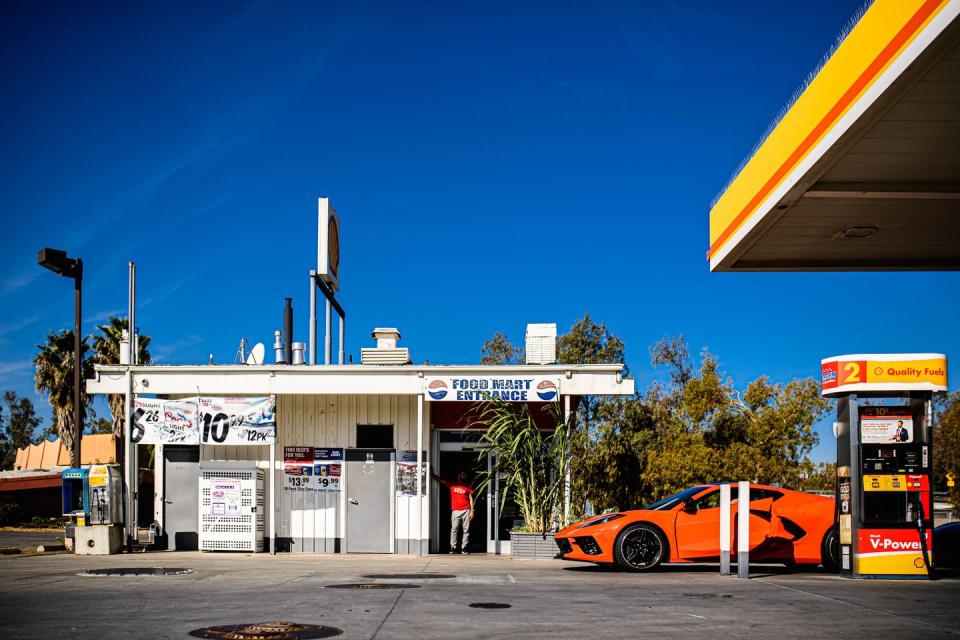
The additional horsepower is almost entirely nixed by the C8’s 203-lb weight gain relative to the C7 Stingray. With a curb weight of 3647 pounds, the new car’s power-to-weight ratio is only about one percent better than the outgoing car’s.
And yet the C8 laid down a blazing 2.8-second 0-to-60-mph run, absolutely crucifying the C7’s 3.9-second performance. Dropping nearly one-third of the time from an acceleration run with no additional power is possibly the biggest coup ever accomplished by an automaker since the miracle of harnessing combustion itself.
That jaw-dropping result comes from the ultrashort gear ratios that Chevrolet chose for the Z51-package C8 to take advantage of the additional grip available on the mid-engine car’s rear tires. At full tilt, the shift from first to second occurs at just over 30 mph. Second maxes at 55 mph. The manual-transmission C7, for comparison, did 51 mph in first.
And to put the 2.8-second 0-60 in perspective, the quickest C7 we’ve ever tested was a 650-hp supercharged 2015 Z06 with the Z07 performance package and 8-speed automatic. It managed “only” a 3.0-second 0-60. In a drag race between the two cars, the Z06 wouldn’t pull ahead of the new C8 until right before the quarter-mile mark, which it reaches a mere tenth of a second ahead, albeit traveling 5 mph quicker.
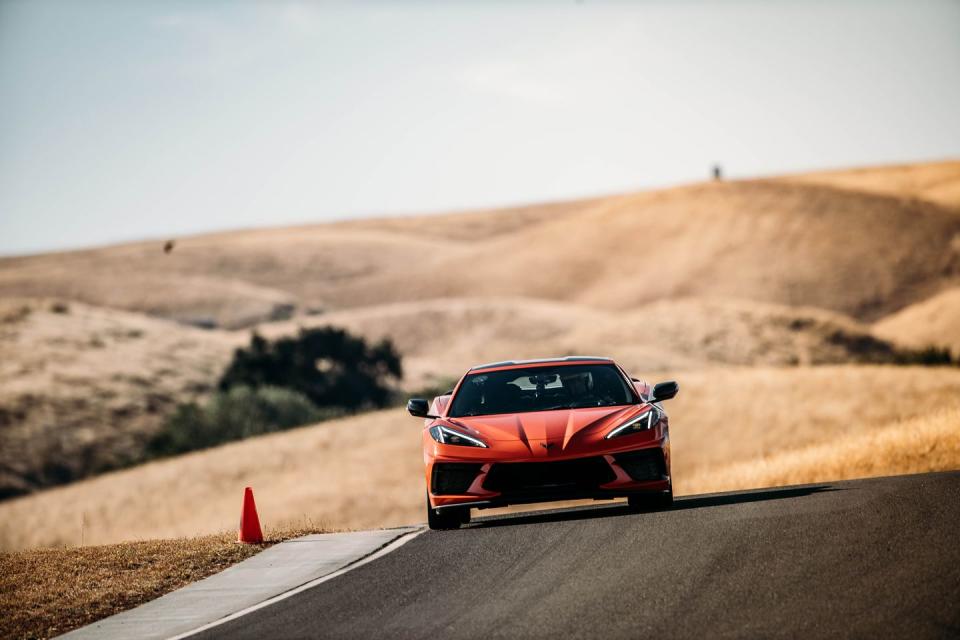
Alas by then, the race has been won. Thanks to gearing, grunt, and grip, the C8 is an astonishing straight-line performer. But the Corvette isn’t just about straight-line performance, and here’s where the mid-engine layout should pay huge dividends. And doesn’t.
Pulling 1.03 g of skidpad grip seems fine—until you realize that the base C7 Z51 managed 1.08 g six years ago. And in that car, the tester’s notes didn’t complain of plowing understeer.
Since understeer can be interpreted as “stability,” several of our editors suspected that this handling characteristic may have been engineered in on purpose by GM to ensure that C8 buyers who have never driven a mid-engine car won’t immediately wrap it around a tree. I doubt this. The violent lifts, spazzy steering flicks, and brake-stabs required to make the Corvette rotate are at odds with the new car’s delicate feel.
The steering doesn’t communicate the handling limits either, neither changing in effort as the front tires fall into understeer nor, more disappointingly, coming alive if the rear end does starts to rotate.
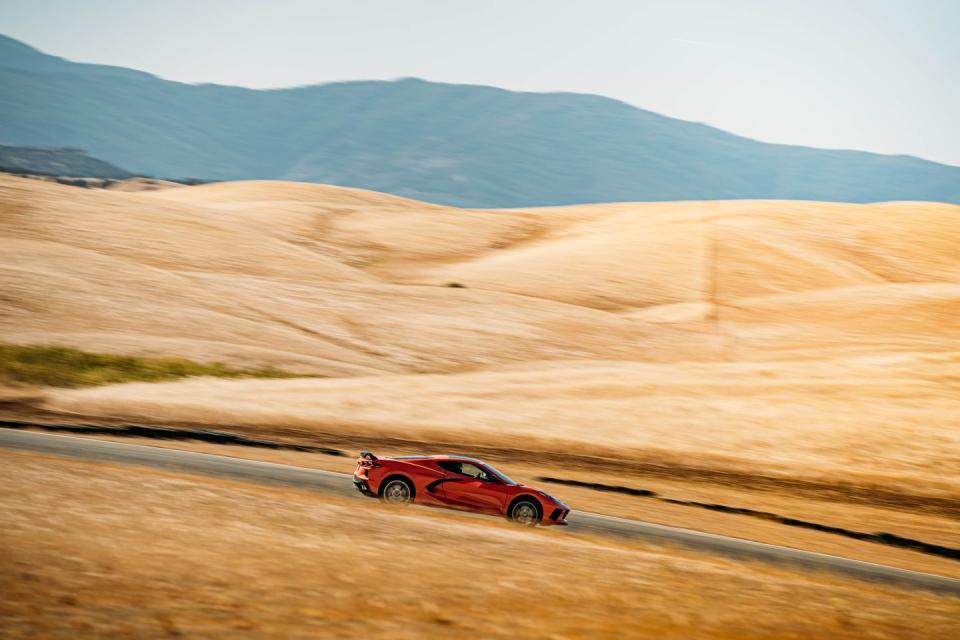
GM’s chassis-tuning track record is coloring our impressions here, but the previous Corvette—as well as the Alpha-platform Camaro, ATS, and CTS—seem to defy the laws of physics at their handling limits. Even if they understeer mildly, those cars’ chassis respond to miniscule additional steering inputs or slight changes in throttle position even at the absolute handling limit, making them continually adjustable. The C8 Corvette doesn’t perform this same magic trick.
Yet. Maybe it’s just a matter of tuning, or tire selection. One GM insider hinted to us that future variants of the Corvette might be less one-dimensional at their handling limits. That will be a welcome upgrade for master-level drivers trained on exotic mid-engine cars. What’s also disappointing is that the 149-foot 70-to-0-mph braking performance stopped short of matching that first C7 Stingray’s 146-foot stop—to say nothing of the several later Stingrays we tested, which stopped as many as 13 feet sooner than that.
When not at the test track, the Corvette’s interior is a quiet and smooth—but somewhat cramped—place to be. The big, dramatic waterfall of buttons is pretty to look at, but the glossy finish on the black buttons renders them unreadable in sunlight. More importantly, that design feature seriously impinges on occupant space—broad passengers on the right side have nowhere to put their arm. They’ll wind up using the driver’s armrest.
Passengers will also hate the positioning of the center-stack touchscreen, which is angled directly at the driver. Forget about asking the Corvette’s passenger to change the radio station or enter a nav destination—even if they could see the screen, they can’t reach it.
Drivers will appreciate the thoughtful layout of information on the screen, and especially the Stealth Mode, which turns off all displays and instrument panel lighting for use on dark roads, leaving only a clear digital speed readout and tiny coolant-temperature and fuel-level gauges.
The sound of the V-8 is artificially enhanced in the cabin, and captures the hypnotic wail of the Small Block’s exhaust perfectly. The optional 14-speaker Bose stereo system is uncommonly powerful.

Our nearly fully-loaded 3LT Z51, were it a production model, would have rung the cash register at $88,810. Without some luxury options like the sport seats, big stereo, and head-up display, this level of performance would be available at a price of around $67,000. This indeed makes the Corvette a mid-engine performance bargain—the closest mid-engine competitor on price would be a Porsche 718 Cayman S.
But the Cayman has (less than) half the engine and trails the C8 in acceleration by three-quarters of a second in both 0-60 and quarter-mile time. While it may have better limit handling, more grip, and better brakes, it sure can’t attract a crowd like the C8. It won’t set the car-enthusiast world on fire.
The C8 already has.
It’s most important to remember that this is only the beginning for the C8 Corvette. It’s our firm belief that the mid-engine switch is a fundamental building block that will do more for the inevitable more-powerful variants than it has for the base car. The C7 Stingray didn’t suffer from a lack of rear-end grip—it was only the Z06 and ZR1 that had trouble putting power to the ground. And once Chevy crams another couple hundred horsepower into the C8, that mid-engine traction will really pay dividends.
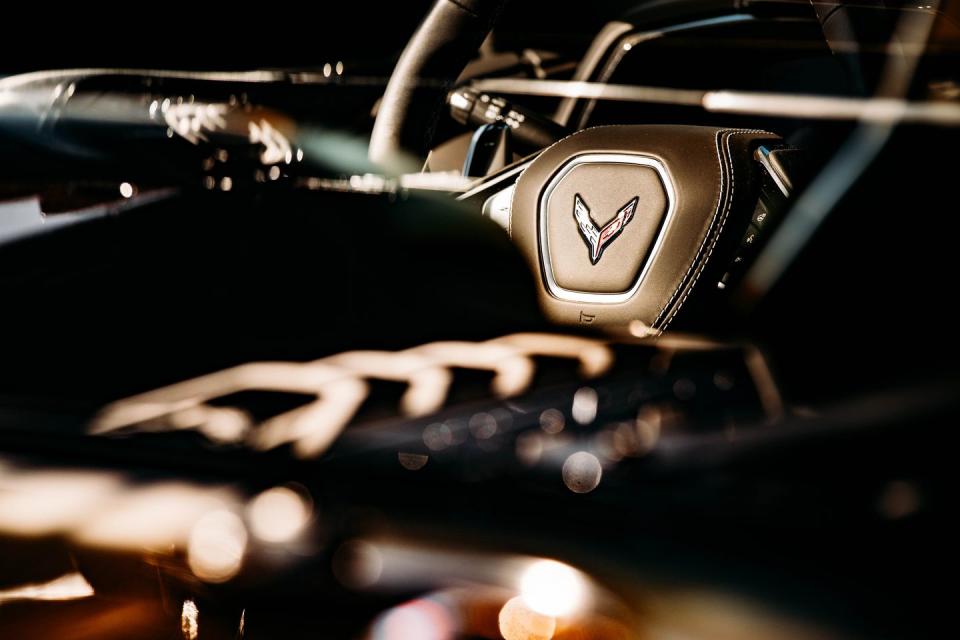
Oh, and we interpret the C8’s by-wire braking system as a tacit admission that a hybrid variant is coming. It’s here that we’ll see the full benefit of the mid-engine layout: it’ll likely have electric motors on the front wheels, allowing GM to make good on the otherworldly handling promise that the Acura NSX didn’t. With torque-vectoring electric power up front, a four-wheel-drive, mid-engined car is the recipe for the best-handling car of all time. It’s where Ferrari—the other God of Chassis Tuning—is going with its upcoming SF90.
So while the C8 Corvette hasn’t redefined mid-engine handling or braking, it’s a very good performer, and it makes good on GM’s outrageous acceleration claims. But the Stingray is only the beginning. It may not yet be great, but the C8 is a momentous start to a new chapter in American sports cars. A very, very quick start.
You Might Also Like

 Yahoo Autos
Yahoo Autos 